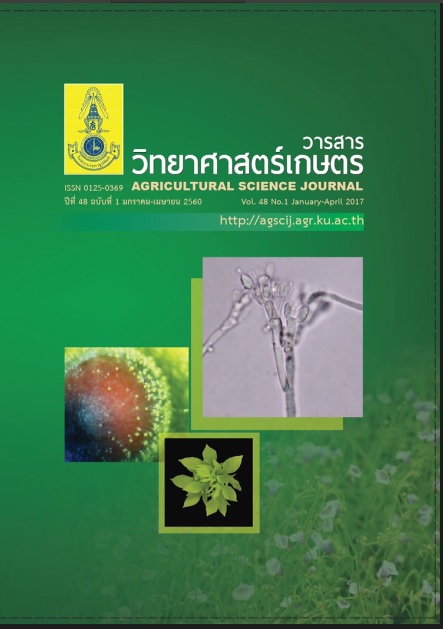Flag Leaf Photosynthesis of Rice var. RD41, Pathum Thani1 and Khao Dawk Mali105 under Elevated CO2
Main Article Content
Abstract
Photosynthesis potential of the flag leaf of three varieties of rice, RD41, Pathum Thani1 (PTT1) and Khao Dawk Mali 105 (KDML105) were evaluated. The plants were grown in pots under natural light condition until flowering. Measurement included light response functions under three levels of air CO2 concentration, Ca= 400, 600, and 800 μmolCO2 mol-1. At Ca 400 μmolCO2 mol-1, all varieties had similar maximum gross photosynthetic rate (Pm) of 30–31 μmol CO2 m-2 s-1. KDML105 required the highest light saturation, generated the highest rates of electron transport (ETR), and photo-respiration (Rl), resulting in having the lowest ratio of CO2 fixed per electron transported (dA/dETR). On the other hand, KDML105 had the lowest level of stomatal conductance (gs), which potentially limited the rate of its net photosynthesis. As Ca levels increased, the whole light response functions were elevated. Pm of RD41 and PTT1 increased 77–103%, while increase of KDML105 was 32%. ETR increased but Rl decreased substantially. Consequently, dA/dETR improved by 40–50%. Of most interest, RD41 and PTT1 could maintain high gs under increasing Ca. KDML105, on the contrary, responded by reducing gs in succession, resulting in gaining less benefit from higher Ca. Measurement of carboxylation process showed that all 3 varieties had similar CO2 compensation points of 58–59 μmolCO2 mol-1 with leaf temperature between 31.2–32.7 ºC. The carboxylation efficiency was high in the range of 124–156 mmolCO2 m-2 s-1.


